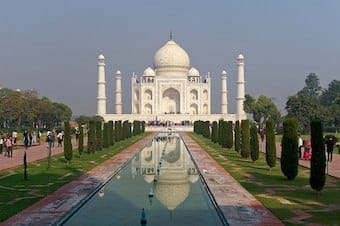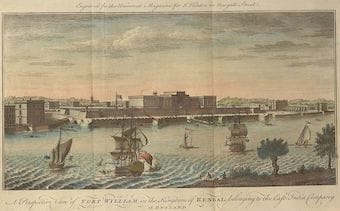A car bowls along one of the high range roads of Kerala, near Munnar close to the eastern border with Tamil Nadu. The network of narrow roads through dense forest, clinging to the sides of steep and rocky hills, was begun in the Raj using British engineering know-how, and formed a key part of the social and industrial progress which historian Ramanath Aiyar describes here, connecting villages and tea-plantations to the capital at Trivandrum and the port at Quilon (Kollam).
BESIDES these, several public works, designed for the protection and promotion of agriculture, such as the Kodayar Irrigation project;* the Paravur and Kaipuzha reclamation schemes; the Kainakary and Puthenchira bunds;* the restoration of the banks of several rivers; the construction of bridges and anicuts* across innumerable rivers and streams, have also been carried out. Similarly the installation of gaslight; the introduction of the Railway;* and the construction of the High Range road are other measures calculated to expand industry.*
Then again, the organisation of a Sanitary Department including Vaccination, vital statistics, rural sanitation and itinerant medical relief, and the contribution of medical grants to Hospitals, Dispensaries and Native Vaidyasalas* demonstrate how largely the health of the people is promoted. And above all, the establishment of the Legislative Council marks the inauguration of an important era.* Every administrative measure of His Highness’ reign is inspired by a genuine solicitude for the welfare of the people.
Abridged and modernised
The Kodayar and Paralayar are the two principal tributaries of the River Thamirabarani (Tamaparani, Kuzhithuraiar). The Pechiparai Dam was constructed between 1897 and 1906 across the Kodayar near the village of Pechiparai in what is now Kanyakumari District, Tamil Nadu, India.
Aiyar’s placenames have been altered here to those used today, to make it easier to pursue further research: Paravur for Parur; Kaipuzha for Kaipuzhai; Kainakary for Kynagari; Puthenchira for Puthencara. A bund is a dam, embankment or causeway, such as those used for agricultural terracing. The word comes from Persian via Urdu.
Another Indian word for a dam used in irrigation.
Surveying for the Quilon–Chenkotta (Kollam-Sengottai) Railway began in 1888 and the line was opened to freight in 1902 and to passengers in 1904, reaching Trivandrum in 1918. The first bus services in the capital began running in 1908.
The high range roads cross the mountainous country of the Western Ghats between modern-day Kerala and Tamil Nadu to the east, and were first engineered by the British. The routes and views, as the roads wind past reservoirs and tea plantations in the shadow of tall mountains, are spectacular.
Ayurvedic medical centres. A Vaidya is a practitioner of Ayurvedic medicine.
This legislature, founded by the Maharajah’s decree on March 30th, 1888, was summoned to advise the Prince on policy and law, and was a historic step towards democratic constitutional monarchy in India. The idea came from the Maharajah’s remarkable diwan, Sir T. Rama Rao.
Questions for Critics
1. What is the author aiming to achieve in writing this?
2. Note any words, devices or turns of phrase that strike you. How do they help the author communicate his ideas more effectively?
3. What impression does this passage make on you? How might you put that impression into words?
Based on The English Critic (1939) by NL Clay, drawing on The New Criticism: A Lecture Delivered at Columbia University, March 9, 1910, by J. E. Spingarn, Professor of Comparative Literature in Columbia University, USA.
Archive
Word Games
Spinners Find in Think and Speak
For each group of words, compose a sentence that uses all three. You can use any form of the word: for example, cat → cats, go → went, or quick → quickly, though neigh → neighbour is stretching it a bit.
This exercise uses words found in the accompanying passage.
1 Establishment. People. Survey.
2 Demonstration. Draw. Progress.
3 Advance. Between. Grant.
Variations: 1. include direct and indirect speech 2. include one or more of these words: although, because, despite, either/or, if, unless, until, when, whether, which, who 3. use negatives (not, isn’t, neither/nor, never, nobody etc.)
Subject and Object Find in Think and Speak
Use each word below in two sentences, first as the subject of a verb, and then as the object of a verb. It doesn’t have to be the same verb: some verbs can’t be paired with an object (e.g. arrive, happen), so watch out for these.
This exercise uses words found in the accompanying passage.
1. School. 2. Promotion. 3. Contribution. 4. Relief. 5. Course. 6. Bank. 7. Development. 8. Country. 9. Tax.
Variations: 1.use your noun in the plural (e.g. cat → cats), if possible. 2.give one of your sentences a future aspect (e.g. will, going to). 3.write sentences using negatives such as not, neither, nobody and never.
Verb and Noun Find in Think and Speak
Many words can serve as noun or verb depending on context: see if you can prove this with the examples below. Nouns go well with words such as the/a, or his/her; verbs go well after I/you/he etc..
This exercise uses words found in the accompanying passage.
1 Land. 2 Tax. 3 Scheme. 4 Range. 5 Draw. 6 Interest. 7 Press. 8 School. 9 Paint.
Variations: 1.if possible, use your noun in the plural, e.g. cat → cats. 2.use your verb in a past form, e.g. go → went. 3.use your noun in a sentence with one of these words: any, enough, fewer, less, no, some.
Add Vowels Find in Think and Speak
Make words by adding vowels to each group of consonants below. You may add as many vowels as you like before, between or after the consonants, but you may not add any consonants or change the order of those you have been given. See if you can beat our target of common words.
sprtd (5+1)
separated. spirited. sported. sprouted. spurted.
aspirated.
If you like what I’m doing here on Clay Lane, from time to time you could buy me a coffee.
Buy Me a Coffee is a crowdfunding website, used by over a million people. It is designed to help content creators like me make a living from their work. ‘Buy Me a Coffee’ prides itself on its security, and there is no need to register.
Related Posts
Sir Henry Craik had heard such glowing reports of Agra’s Taj Mahal, that he was afraid it might prove to be an anticlimax.
Picture: Jakub Hałun, Wikimedia Commons. Licence: CC BY-SA 4.0.. Source.
Posted February 3 2021
Lakshmi and her sister Parvati enlisted the help of the British Resident, Colonel Munro, to steady the Kingdom of Travancore.
Picture: By Raja Ravi Varma (1848-1906), via Wikimedia Commons. Licence: Public domain.. Source.
Posted May 31 2019
Adam Smith argued that the Bengal Famine of 1769 would have been much less of a tragedy under a free trade policy.
Picture: Via Wikimedia Commons. Licence: Public domain.. Source.
Posted December 29 2017






